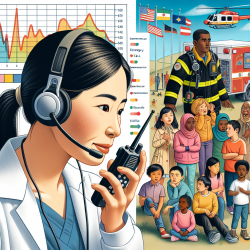Introduction
In the ever-evolving field of speech-language pathology, practitioners are constantly seeking innovative ways to enhance their skills and improve outcomes for their clients. A recent study titled "Exploratory analysis of real personal emergency response call conversations: considerations for personal emergency response spoken dialogue systems" offers valuable insights that can be applied to our practice. This blog post will delve into the key findings of the study and explore how practitioners can leverage this information to refine their approaches and encourage further research.
Understanding the Study
The study conducted an exploratory analysis of real personal emergency response (PER) call conversations to improve spoken dialogue systems. By examining these conversations, the researchers aimed to develop a model of personal emergency response, identify key conversational features, and understand the relationships between these features and the model. The ultimate goal was to enhance the artificial intelligence and decision-making capabilities of spoken dialogue systems in emergency response scenarios.
Key Findings and Implications for Practitioners
- Identifying Caller Types: The study found that by analyzing verbal abilities and conversational structures, practitioners can identify caller types with moderate accuracy. This is crucial for tailoring interventions and responses to individual needs.
- Understanding Conversational Patterns: Different caller types, such as older adults and care providers, use distinct conversational strategies. Recognizing these patterns can help practitioners adapt their communication approaches to better support clients in emergency situations.
- Predicting Target Responses: By understanding the relationship between conversational features and response types, practitioners can predict target responses with some degree of probability. This can inform the development of more effective intervention strategies.
Encouraging Further Research
The study highlights the importance of using real conversational data to inform the design of spoken dialogue systems. Practitioners are encouraged to engage in further research to explore the nuances of emergency response conversations and their implications for speech-language pathology. By collaborating with researchers and leveraging data-driven insights, practitioners can contribute to the development of more robust and effective communication interventions.
Conclusion
As speech-language pathologists, our commitment to data-driven decision-making and evidence-based practice is paramount. The findings from this study provide valuable insights that can enhance our understanding of emergency response conversations and inform our interventions. By embracing these insights and pursuing further research, we can continue to improve outcomes for our clients and contribute to the advancement of our field.
To read the original research paper, please follow this link: Exploratory analysis of real personal emergency response call conversations: considerations for personal emergency response spoken dialogue systems.










